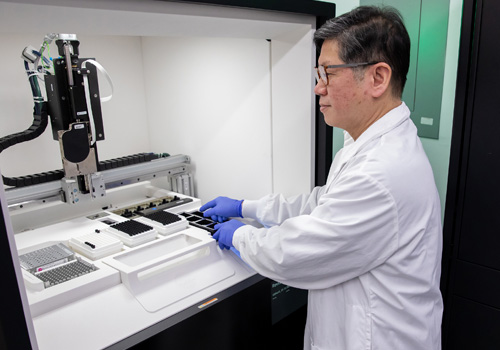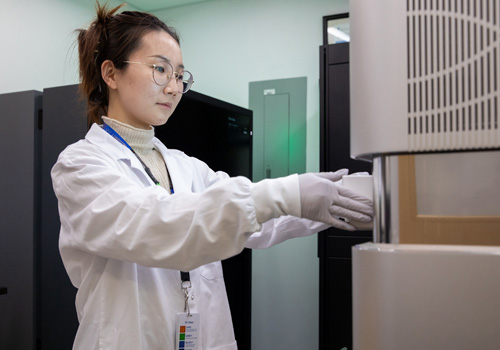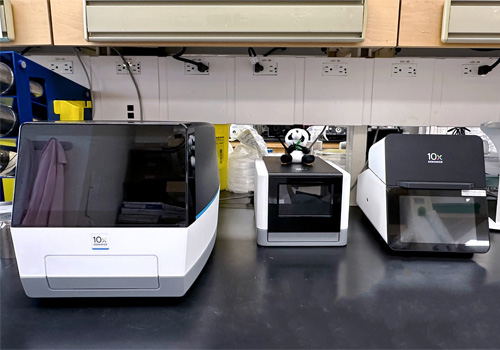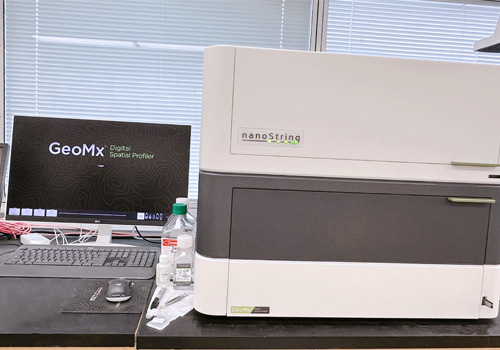1. Gene Function Analysis
CRISPR-based functional screens (gene knockout or activation) connect changes in genotype to phenotypic output and are commonly applied to find genes essential to
a particular experimental condition. In these assays, a pooled lentiviral single guide (sg)RNA library is used where each sgRNA is identified by a unique barcode.
Typical screens involve endpoint reads where changes in sgRNA frequency in the cell population across different experimental conditions are identified by NGS.
Analysis is performed using an Illumina short read sequencer to identify and quantify the barcodes for each unique sgRNA. Confirmation of on- and off-target
integrations, if required, can be performed using long-read sequencing on the PacBio Revio system. This will also identify any genetic variations, such as single
nucleotide variants (SNVs), that have introduced allele-specific Cas9 cleavages.
2. Whole Genome Sequencing
We provide whole genome sequencing capabilities using either short or long read sequencing. Short read sequencing provides higher depth, is typically cheaper, and
is still an effective route for analyzing well-characterized genomes. Long-read sequencing using the PacBio Revio offers the advantages of identifying complex
structural variations (large insertions/deletions, inversions, repeats and duplications, and translocations) and is best suited for de novo genome assembly and for
phasing single nucleotide polymorphisms (SNPS) into haplotypes.
3. Bulk Gene Expression Profiling
Bulk RNA sequencing (RNA-seq) from cells, tissues or organoids enables gene expression profiling between different conditions. Whole transcriptome, whole exome,
or targeted sequencing options are available. For differential expression analysis, transcripts (after conversion to cDNA) are sequenced using short-read technology
to identify and quantify RNA expression levels. For mapping of full-length isoforms to identify splicing variants or alternative start and end points of a
transcript or to assign SNPs to specific isoforms, the analysis is performed using our long read PacBio Revio sequencer.
4. Single Cell Biology
Isolation of single cells or single nuclei prior to RNA or DNA sequencing enables gene expression, chromatin structure, and copy number alterations to be assessed
at the single cell level within mixed cell populations. Lineage tracing can also be performed using barcoding. The 10X Chromium platform available in the NBCC is
the core technology that enables easy and efficient partitioning of individual cells for single cell mapping.
5. Spatial Profiling
We offer spatial transcriptomic profiling of both formalin-fixed paraffin-embedded (FFPE) and fresh frozen tissue using Nanostring’s GeoMX digital spatial profiler
coupled to Illumina sequencing. Regions to profile are selected based on fluorescent staining patterns of selected markers.
6. Multiplexed Functional Screens
Dr. Jeff Wrana in collaboration with Dr. Ben Blencowe (University of Toronto) developed a multiplexed and quantitative functional genomics screening platform that enables screening
in multi-well plates (e.g. different drug conditions or siRNA screen), barcoding of samples and NGS readout of changes in gene regulation (it was first used to
monitor changes in alternative splicing (Han et al. Molecular Cell, 2017)). A variation of this assay, C19-SPAR-Seq, was developed to track SARS-CoV-2 variant dynamics.
7. Pathogen Detection and Profiling
NGS is ideally suited to detect novel and existing pathogens in an unbiased manner through metagenomic or metatranscriptomic sequencing with the benefits of being
able to identify potential co-infections and follow host response to infection. In addition to unbiased screening, different strains of bacteria can be identified
through 16S/internal transcribed spacer (ITS) ribosomal RNA sequencing and other targeted methods (including variations of SPAR-Seq as noted above).
8. The “Latest Acronym”-Seq
New applications and approaches to sample preparation and sequencing analysis are continually being developed most of which are identified by an acronym
(e.g., ATAC-Seq to identify transposable-accessible chromatin, ChIP-Seq for chromatin immunoprecipitation followed by sequencing to profile DNA-binding proteins….).
If you have an application of interest, have heard of a specific technology, or have an idea you want to discuss, please contact us.





